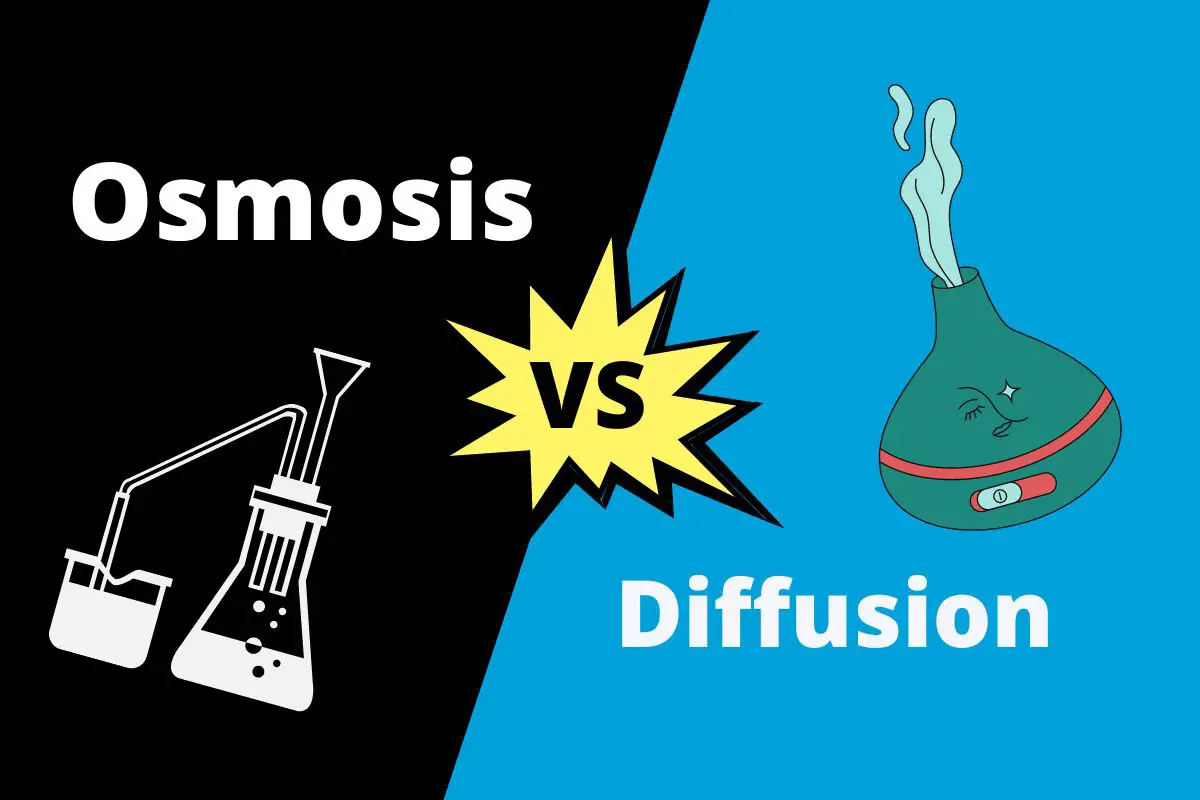The main difference between osmosis and diffusion is that osmosis allows only solvent molecules to pass through the semipermeable membrane. However, diffusion allows both solute and solvent molecules to move freely.
In order to understand how molecules move, you’ll need to know the difference between two processes – osmosis and diffusion.
Table of Contents
What is the Difference Between Osmosis and Diffusion?
| Osmosis | vs | Diffusion |
| Only water or solvents can move from higher to lower concentrations | Types Of Substances Allowed | Any substance can move from higher to lower concentration |
| It takes place in a liquid medium only | Medium | It takes place in all three mediums – solid, liquid, and gas |
| Concentration doesn’t equalize | Concentration | Concentration equalizes |
| It requires a semipermeable membrane | Membrane | It does not require any membrane |
| Distribution of nutrients and the release of metabolic waste products. Plants are responsible for the absorption of soil water | Importance | It helps exchange gases during respiration, photosynthesis, and transpiration. |
What is Osmosis?
Osmosis is the process in which the movement of water molecules takes place from a low concentration solution to a higher concentration solution. This movement takes place through a semi-permeable membrane.
Semi-permeable Membrane
This cell membrane is also called a partially or selectively permeable membrane because it only allows specific molecules to cross through it.
The movement of molecules is also described as the gradient movement as the molecule moves from higher to lower concentration. A concentration gradient contains stored energy that drives diffusion.
All the solvents can undergo osmosis, including gasses and supercritical liquids. There are three types of osmotic solutions: isotonic, hypertonic, and hypotonic.
Types of Osmosis
Endosmosis
Endosmosis happens when a cell (substance) is kept in a hypertonic solution, water (solvent) moves inside the cell, making it puffy or plasmolyze. This is because the solute concentration in the solution is less than the concentration in the cell.
Exosmosis
Exosmosis occurs when a cell (substance) is kept in a hypotonic solution, water (solvent) from the cell moves outside and makes it flaccid or undergoes plasmolysis.
This is because the solute concentration in the solution is more than the concentration in the cell’s cytoplasm.
Reverse Osmosis
In reverse osmosis, pressure is applied to move solvent particles through a semipermeable membrane. This forces the solvent to move from a higher solute concentration region to a lower solute concentration region.
Reverse osmosis is one of the most popular methods to purify water.
Forward Osmosis
Forward osmosis involves the separation of dissolved solutes from water using a semipermeable membrane. Water treatment takes advantage of forward osmosis.
Examples of Osmosis
- Absorption of water from soil happens via osmosis
- Swelling up of guard cells of the plants to open stomata also occurs because of osmosis
- Humans suffering from cholera are also affected by osmosis

Why is Osmosis Important?
Osmosis is critically important in nature, especially in plant life.
- Osmosis affects the transport of nutrients and the release of metabolic waste products.
- It’s responsible for absorbing water from the soil and conducting it to the upper parts of the plant through the xylem.
- It maintains the turgidity of cells, which helps regulates the movement of plants and plant parts.
- Osmosis helps plants maintain their water content despite the constant water loss due to transpiration.
What is Diffusion?
Diffusion is the random movement of molecules from an area of high concentration to a lower concentration. Diffusion takes place in all living beings.
The molecules keep moving from high to low regions until the concentration becomes equal. All three states of matter undergo diffusion, i.e., solid, liquid, and gas.
Factors Impacting Diffusion
- Temperature
- Size of particle
- Area of interaction
- Steepness of the concentration gradient
Types of Diffusion
Diffusion is an essential process in physics, chemistry, and biology. It can be broken down into two types – simple diffusion and facilitated diffusion.
Simple Diffusion
In a simple diffusion process, the particles move without the support of transport proteins.
Facilitated Diffusion
In facilitated diffusion, the particles move with the help of carried proteins.
Examples of Diffusion
- A tea bag dipped in hot water diffuses to change the color of the water
- A perfume sprayed in the room diffuses in the air
- Sugar dissolves in lemon water to change the taste

Osmosis Vs. Diffusion – Key Differences
Substance Allowed
Only water or solvents can move from higher to lower concentrations in osmosis. However, any substance can move from higher to lower concentration in diffusion.
Medium
Osmosis takes place only in the liquid medium. On the other hand, diffusion occurs in all three mediums – solid, liquid, and gas.
Concentration
In osmosis, the solvent concentration does not become equal on both sides. However, diffusion continues until the concentration on both sides becomes equal.
Membrane
While osmosis requires a semipermeable membrane, diffusion does not require any membrane.
Importance
Osmosis affects the distribution of nutrients and the release of metabolic waste products. In plants, osmosis is responsible for the absorption of soil water.
Diffusion, however, creates energy and helps exchange gases during respiration, photosynthesis, and transpiration.
Osmosis and diffusion are both critical passive transport processes that do not require any energy to take place. However, they’re different from each other in terms of concentration, medium, and other factors.

